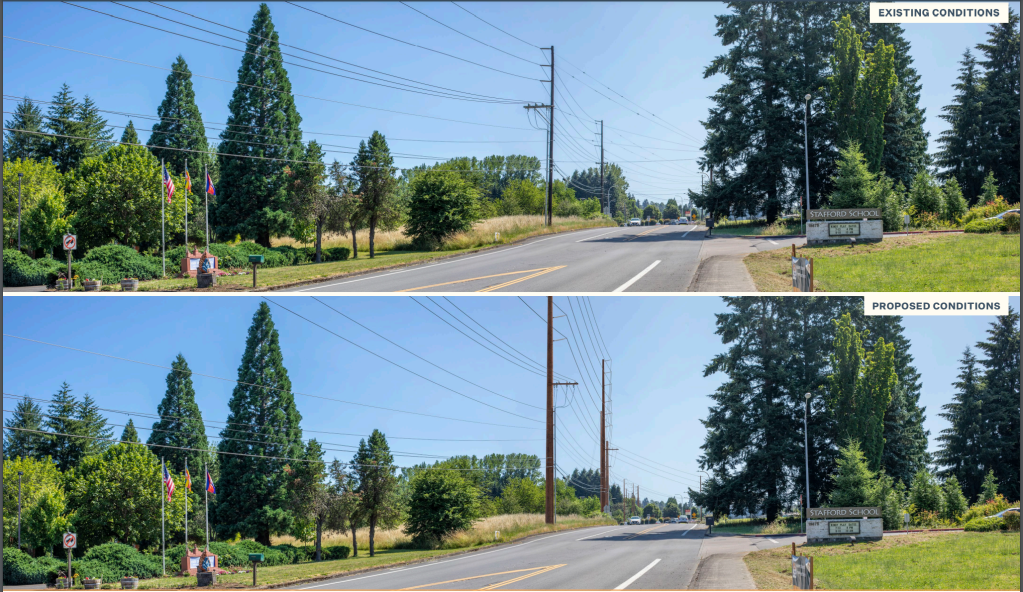Stafford Road residents remain concerned over Portland General Electric’s Tonquin Project
Published 2:27 pm Monday, August 5, 2024

- A simulation shows what one section of Stafford Road could look like after completion of upgrades to power poles and transmission lines related to the Tonquin Project. (Submitted by Portland General Electric)
Residents along Stafford Road remain at odds with Portland General Electric as preparations continue for the company’s Tonquin Project.
PGE is petitioning the Oregon Public Utilities Commission for a Certificate of Public Convenience and Necessity that could be used in a proceeding to condemn property in relation to the Tonquin Project, which involves upgrading 11 miles of transmission lines in the southern part of PGE’s service area.
Part of the Tonquin Project includes upgrading power poles along Stafford Road between the Rosemont and Wilsonville substations — a project that has long been of concern for residents who believe the upgrades could lead to increased fire and health risks, and a decline in property values.
Trending
According to PGE’s March 27 notice of intent to file a petition for the CPCN, the company has already obtained 78% of the necessary easements for the upgraded poles. But, the letter said the company “anticipates it may need to initiate condemnation proceedings to gain access to certain parcels along the route for the Rosemont-Wilsonville line.” PGE is required to petition for a CPCN if condemnation of land will be necessary for a transmission line.
PGE spokesperson Andrea Platt said the majority of the poles are within a public right-of-way, but some require easements from property owners due to being on private property.
“While condemnation is not the company’s preferred path and the company will continue to negotiate in good faith with the landowners to avoid condemnation wherever possible, PGE must initiate the CPCN proceeding to ensure that it will have the necessary access,” Jocelyn Pease, attorney for PGE, wrote in the March 27 letter.
When evaluating PGE’s petition, the commission will determine the “necessity, safety, practicability and justification in the public interest,” according to a commission list of frequently asked questions. If the certificate is granted, Platt said it could be used as evidence in a court proceeding if it becomes necessary to condemn properties for the project.
Ed Wagner, Stafford Road resident and a leader in the campaign to oppose the upgraded power lines, said the community has raised $93,000 for its cause in the last year. Wagner said the funds primarily have gone to legal fees, but some also went to outside utility experts.
“We spend it as fast as we can raise it,” Wagner said. “But unfortunately, after a year of asking people to provide funds, it’s starting to slow down. So it’s going to become more and more difficult to pay our legal bills.”
What is the Tonquin Project?
Trending
Along with the 11 miles of upgraded 115kV transmission lines, the project involves adding a new substation in the southern portion of PGE’s service area, according to the website. Platt said the project will help modernize the power grid, allowing for redundancy to help accommodate future growth and reduce power outages locally and in the region.
Redundancy allows for different paths power can travel along, which Platt compared to vehicles being able to to take alternative routes to a destination if one road is blocked.
Platt said there are two nearby substations that are nearing capacity and the improved lines will ensure “additional routes for power to travel.” This can help restore power more quickly during an outage, she said.
There are 7.4 miles of distribution power lines between the Wilsonville and Rosemont substations, which will be upgraded to distribution and transmission lines. Platt said poles will be required to be larger in some places to maintain required clearances from trees and accommodate the additional lines. Wagner said residents are concerned over the increase in power pole size.
Resident concerns
Along with health concerns associated with living near the power lines, Wagner said fire danger remains a significant worry for residents. He cited examples of structures that have burned down in the past.
Tualatin Valley Fire & Rescue division chief Cassandra Ulven said the Stafford Road area is considered a wildland urban interface area, noting that the area has no fire hydrants and some “nice homes.” But Ulven said the area is well protected, pointing to multiple fire stations near the area and a mutual aid agreement with the Lake Oswego Fire Department.
“So as far as our ability to quickly mobilize resources when a fire occurs, we are better equipped in that interface area than we are in any of our other interface areas based on the existing infrastructure we have,” Ulven said. She also added that there have been brush fires in the Stafford Road area in the past that TVF&R was able to protect structures from.
Ulven said TVF&R is neutral on the Tonquin Project, but noted that the agency is not concerned about it from an emergency response standpoint.
Platt said safety is a top concern for PGE and the company has strategies for wildfire mitigation — including upgrading equipment and expanding tree trimming and vegetation management in high-risk areas.
“Some of the easements (along Stafford Road) that we have sought are to remove trees that would be too close or would not meet clearances to maintain a safe distance from equipment,” Platt said.
Wagner said the removal of old growth trees is another resident concern. He gave an example of one property owner living on Gage Road, which is close to Stafford Road, who will lose trees offering a barrier between their home and the road. Wagner said that although PGE has indicated to some property owners that it will replant trees, “in most of our lifetimes, we won’t see the full growth of these trees.”
At a virtual hearing on Tuesday, July 23 Stafford Road resident Jeanie Braun discussed concerns about fire, the safety of having power lines close to her home and a potential loss of property value. She believed her $1.5 million home could not be sold at full value due to a power pole being “right in her kitchen window.”
“These lines are not just an inconvenience. They’re not just an eye sore,” Braun said, adding that she acknowledges that power is a necessity and she believes the safety benefits of putting the power lines underground would be worth the challenges.
In a past interview, Platt said that undergrounding the power lines would come with trade offs such as significant cost increase, potentially requiring more easements and demanding more time, resources and heavy equipment to repair if needed.
What PGE needs to move forward
In order to use property outside of the right of way, Platt and Wagner said PGE is also required to get a permit from Clackamas County. Platt confirmed in an email that the company is in the process of acquiring the permit, which involves receiving signatures from those affected by the easements.
Wagner said there are 12 people within the organization opposing the powerline upgrades who “refuse” to give their signature for the permit. In response, Platt said in an email that “PGE is taking the steps required by the permitting process that is underway. The timeline for resolution is not imminent.”
Although PGE would normally be required to include an approved land use permit when filing for the CPCN, it received a waiver to apply without the approved permit. According to a July 16 letter to the utilities commission from a lawyer representing PGE, the company appears to need the approved land use permit in order to be granted a CPCN.
“While the commission issued a waiver to allow PGE to file its petition for a Certificate of Public Convenience and Necessity prior to the receipt of Clackamas County’s land use authority, the commission made clear at its public meeting that it would not issue a CPCN until that permit had been secured and offered into evidence in this case,” stated a July 16 letter from the commission to the lawyer representing PGE. It added that Clackamas County’s requirement for signatures or a secured CPCN places the company “in an impossible position.”
The letter said PGE has “identified several paths” it can pursue with the county to address the requirements.
The Public Utilities Commission held a virtual hearing on Tuesday, July 23 on the Certificate of Public Convenience and Necessity, and an in-person hearing on Tuesday, July 30 at the Century Hotel in Tualatin.
If the petition is denied, Platt said in an email that PGE could consider pursuing another petition that addresses issues raised in the denial, while also continuing to work with property owners to obtain easements.
More information about the Tonquin Project can be found on the website.







